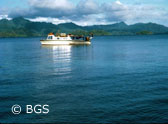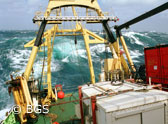Development and demonstration of a Digital Terrain Model and 3D viewing software
Following the user consultation Geo-Seas undertook developments for:
- Definition of the characteristics of bathymetric grids (digital terrain models) as required by end-users
- Specification of procedures for combining different data sources and features in a target digital terrain model (DTM)
- Development of a pilot DTM as a case study in order to evaluate the feasibility of generating such grids and services in accordance with end-user requirements whilst taking into account the constraints resulting from the use of multiple datasets from a variety of data sources (the data being made available by Geo-Seas data centres).
The analysis has resulted in a document with a list and definitions of DTM products with guidelines for description and representation based on user requirements. This provides the specifications for the generation of prototype bathymetric digital terrain models (DTMs) and 2D and 3D tools for viewing the DTMs.
A 3D visualisation tool (3D Viewer) based on the existing open source NASA World Wind JSK application has been developed. This software is freely available after registration and allows the visualisation of Digital Terrain Models (DTM) in the existing CARAIBES NetCDF format and Web Map Service (WMS) which are plugged into a virtual globe.
- Register and Download the 3D DTM Viewer software
- User Manual of 3D DTM Viewer
- Installation Manual of the 3D DTM Viewer
A case study has been developed to validate the process for the production of a complex DTM. Data have been made available (x,y,z) for an area where data sets of various resolutions and origins exist for the southern Celtic Sea (Irish and French data sets). These data have been gridded using the specification outlined above and then merged in order to prove the feasibility of the process for the development of complex digital terrain models using gridded x, y, z data at varying resolutions.
Each file contains a series of layers among which a "depth" layer containing the mean depth at each node, a "smoothed depth" layer resulting of the application of a spline function, and a source layer containing the identifiers allowing to access metadata of datasets used at each node of the grid using the Geo-Seas Common Data Index (CDI) and the European Directory of Marine Organisation (EDMO) catalogue.
The 3D Viewer can also import and visualise the NetCDF (CF) files of the Digital Terrain Model that is being developed in the framework of the EMODNet Hydrography, Seabed Mapping and Bathymetry projects. These can be downloaded by means of the EMODnet Bathymetry Viewing and Download service.
The 3D Viewer was demonstrated to potential users during the Geo-Seas workshop at the Oceanology International exhibition in London on 14 March 2012.
The production of a complex DTM includes two distinct phases of activity:
- Provision of the formatted data: the data provider can either provide raw xyz data at a resolution/distribution corresponding to the characteristics of its sounders or alternatively at a specific resolution (pyramidal level of resolution) which includes specific additional variables.
- Gridding of the data: data provided as xyz requires gridding for the purpose of developing the DTM. Scripts and documentation developed using the open source Generic Mapping Tools (http://gmt.soest.hawaii.edu) can be used for formatting data. An alternative solution is using the CARAIBES software of IFREMER. As part of Geo-Seas 2 training workshops took place (6 to 9 December 2011 and 9 to 10 January 2013) during which Geo-Seas partners were given instructions on the data gridding method and also trained in the use of the GMT, CARAIBES and 3D DTM Viewer software tools.
These pilot DTMs are based upon the interim NetCDF format which works with the GMT scripts or CARAIBES software. This is an interim situation, because further work is underway in Geo-Seas together with SeaDataNet to formulate improvements to the NetCDF format for ensuring interoperability with the IHO S100 standards (INSPIRE compliant bathymetric data product formats) and for implementing the common vocabularies using the CF convention. The DTM specification will be finalised later but this harmonisation of the NetCDF formats is fundamental for ensuring future interoperability of these formats.


